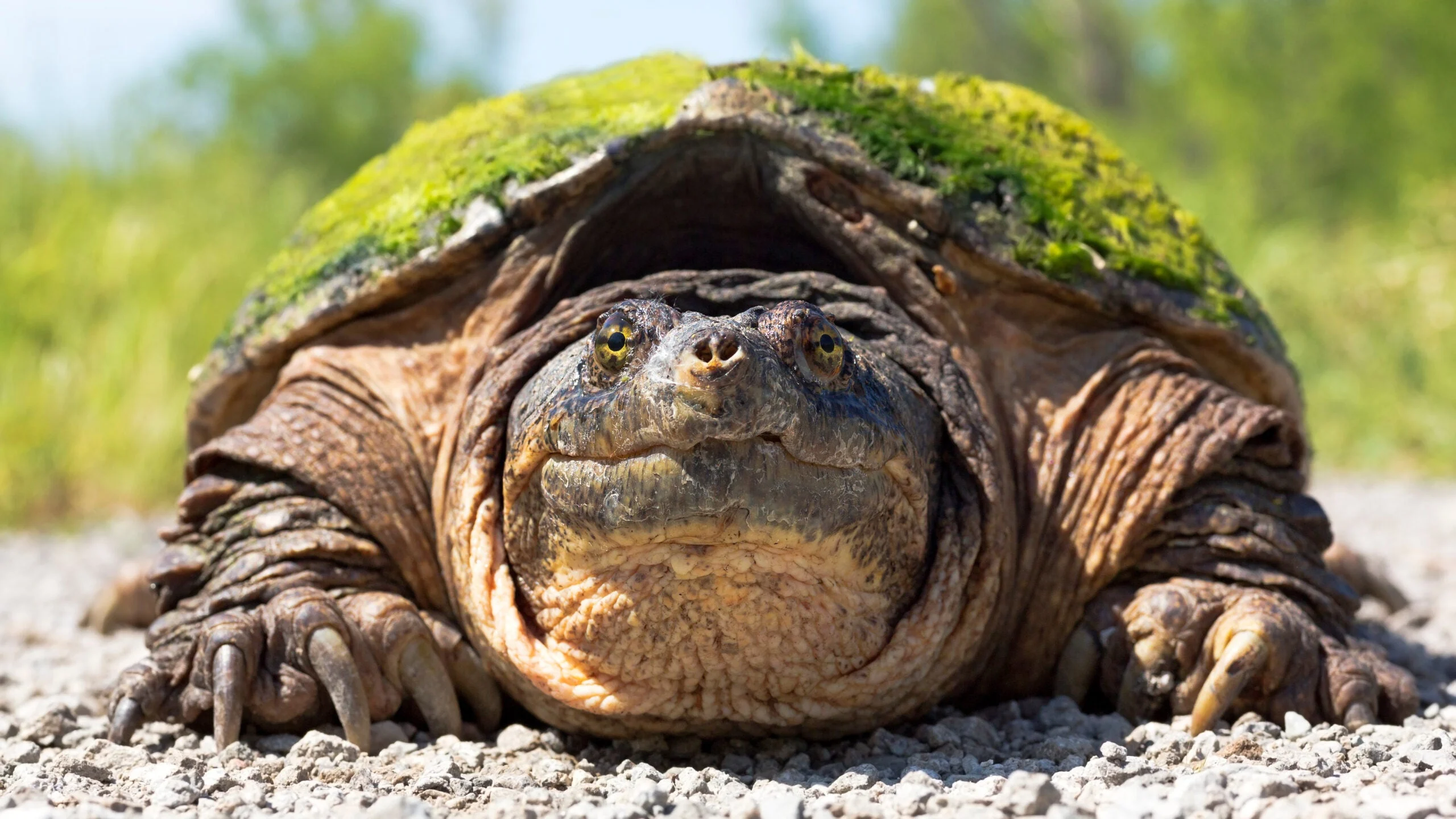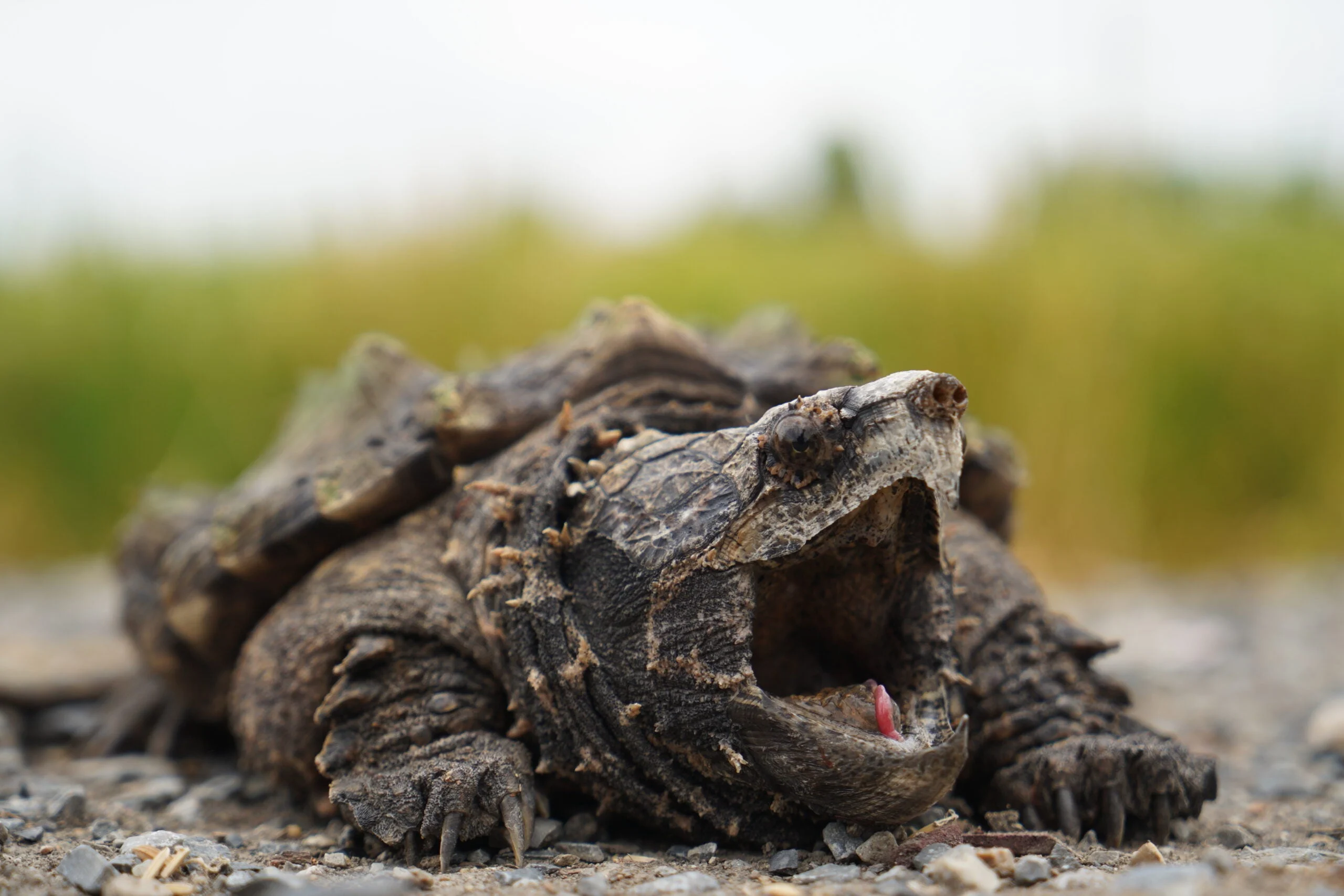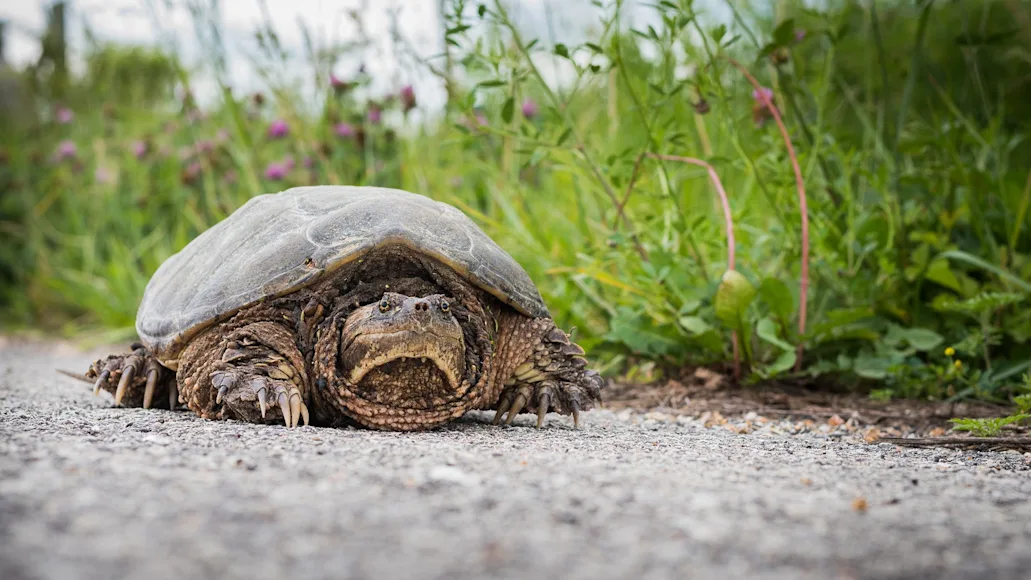Snapping turtles are opportunistic omnivores that will eat almost anything in the pond. While they prefer meat, including worms, snails, fish, birds, small mammals, other turtles, and frogs, 30 percent of their diet consists of water plants. So, what do snapping turtles eat? Pretty much anything they can get their claws on.
Key Points
Snapping turtles eat a wide range of plants and animals, including algae, fish, and birds
They eat animals ranging in size from insects to geese
70 percent of their diet consists of meat

Snapping turtles have long curved claws, tubercles adorning their neck and legs, a hard, sharp beak, and algae sprouting from its back. Adobe Stock / Patrick Rolands
Snapping turtles have long curved claws, tubercles adorning their neck and legs, a hard, sharp beak, and algae sprouting from its back. They may be furtive and deliberate, but snapping turtles are omnivorous eating machines, known to devour almost anything they encounter that is edible and smaller than they are. Plants? Snap. Insects? Snap. Invertebrates? Snap. Fish? Snap. Reptiles and amphibians? Snap, snap. Small mammals, dead or alive? Snap. In this article, we’ll break down all the snapping and tell you exactly what snapping turtles like to eat.
Table of Contents
A Long Time Snapping
Designed for Snapping
What Do Snapping Turtles Eat?
Tricks of the Snapping Trade
Not a Threat to Game Fish and Waterfowl Populations
What to Feed Pet Snappers
Frequently Asked Questions
A Long Time Snapping
Snapping turtles have lived in the rivers, ponds, lakes, and swamps of our green earth for 90 million years. They evolved in North America alongside the dinosaurs and long outlived them. A branch of the family spread to Eurasia 40 million years ago, but disappeared 38 million years later. Today, two North American species, the common snapping turtle and the alligator snapping turtle, remain. Common snappers range from Nova Scotia to the Gulf of Mexico, while their spikier cousins are mostly found in the southern states west to Texas.
Designed for Snapping

Alligator snappers have peaks on their hilly shells and spikes on their legs and neck. Adobe Stock / Sista
Snapping turtles are North America’s largest turtle species. Male alligator snappers can reach up to 29 inches long and weigh up to 250 pounds. Common snappers can reach about a third that size, but typically weigh in from 10 to 35 pounds. Both look like boulders
, but alligator snappers have peaks on their hilly shells and spikes on their legs and neck. The most prominent feature of both species, though, is their snapper, as common snapping turtles can chomp with a bite force of 209 Newtons on average, while alligator snappers clamp their jaws with an average of 158 Newtons of force. Both are strong enough to bite through bone.
What Do Snapping Turtles Eat?
So, what are they snapping on with such force? Here’s the menu:

Tricks of the Snapping Trade
Snapping turtles are both scavengers and hunters. While young turtles largely forage for food, hunting adults tend to wait, with their mouths wide open, for their prey to come to them. Algae growing on their backs helps them camouflage when dangling motionless in the water or lying on the muddy bottom of a waterway ready to ambush an unsuspecting victim. Alligator snapping turtles
even have specialized fishing gear—a built-in lure. Attached to the tip of their tongues is a pink, worm-like appendage, which dangles to attract fish right into the trap. Both species scour the basin of their watery pantry at night, both exclusively feed in the water, and both can hold their breath for up to 50 minutes, giving them ample time to haul in a satisfying meal with each dive.
Not a Threat to Game Fish and Waterfowl Populations
Snapping turtles have been thought to decimate the populations of game fish and waterfowl in the waters where they lurk. But scientific studies have shown this is a fallacy. Because they have such a varied diet, and because they tend to eat smaller fish, not mature egg layers, they do not put a significant dent in game fish populations. Mammalian nest predators and large fish, meanwhile, kill far more waterfowl. On the other hand, by consuming diseased, dying and dead water denizens, snappers help keep their waters healthy and clean.
What to Feed Pet Snappers
Snapping turtles in captivity can be fed:
Live insects (crickets, grasshoppers)
Raw chicken and turkey meat
Worms (including mealworms)
Leafy greens (mustard, romaine)
Fish (minnows, guppies, goldfish)
Aquatic plants (duckweed, moss)
Crustaceans (ghost shrimp, crayfish)
Vegetables (carrots, corn, celery)
Fruit (apples, peaches, bananas, berries, watermelon)
Frequently Asked Questions
Do snapping turtles attack humans?
They are not normally aggressive toward humans, but have been known to sever a finger or two.
Do other animals eat snapping turtles?
Their eggs and hatchlings are preyed upon by many of the things they eat and some they don’t, including bullfrogs, coyotes, skunks, foxes, fish (like pike and bass), snakes, owls, hawks, herons, crows, minks, fishers and racoons. Even adult snapping turtles eat the little ones. Sometimes river otters, bears, and coyotes attempt to attack adult snappers. In the southern states, American alligators and river otters occasionally eat them and alligator snapping turtles occasionally eat common snapping turtles. Humans also eat them.
Do snapping turtles have teeth?
While snapping turtles have no teeth, hatchlings have a toothlike growth on the ends of their noses, which they use to pierce the leathery eggshell. It falls off shortly after they hatch.






